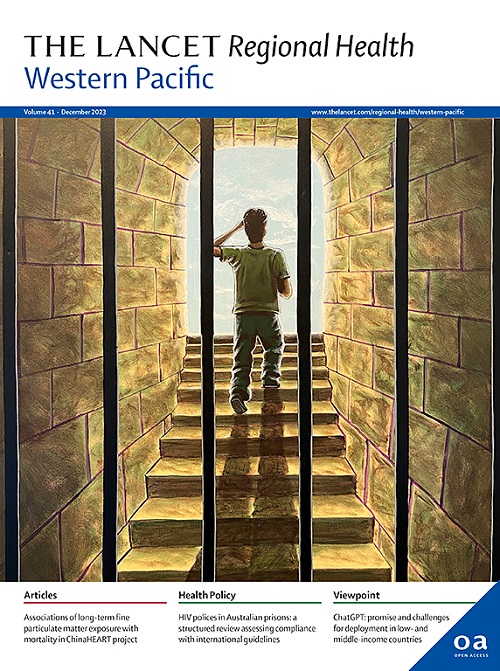A decade of Benzodiazepine and Z-drug use in Hong Kong: a longitudinal study
IF 8.1
1区 医学
Q1 HEALTH CARE SCIENCES & SERVICES
引用次数: 0
Abstract
Background
Concerns are growing about the long-term use of benzodiazepines (BZDs) and non-benzodiazepines (Z-drugs) due to adverse effects such as drug tolerance, dependence, cognitive dysfunction, and falls, particularly in the elderly. This study aims to understand thorough prescribing patterns of BZDs and Z-drugs across age groups in clinical settings of Hong Kong, especially the long-term prescriptions.
Methods
Using territory-wide electronic health record data from Hong Kong (2014–2023), we analysed the prevalence, incidence, and duration of BZD and Z-drug prescriptions in adults. Long-term use was defined as prescriptions exceeding 90 days. Joinpoint regression models assessed trend changes, focusing on four age groups: 18–25, 26–49, 50–64, and ≥65. Psychiatric diagnoses within 180 days before and after treatment initiation were also evaluated.
Findings
Patients with BZD and Z-drug prescribing increased from 2014 to 2023, with an average annual percentage change (AAPC) of 3.44 [95% CI: 3.26–3.61] in prevalence and 1.51 [0.64–2.45] in incidence. Trends varied by age: the sharpest increases were observed in young adults aged 18–25 (prevalence AAPC: 9.43 [8.36–10.51]; incidence AAPC: 7.56 [6.19–8.89]), whereas the incidence in those aged ≥65 declined after 2019, although it remained the highest. Prevalence of patients with long-term prescribing rose consistently, particularly in young adults (BZD AAPC: 13.43 [11.98–14.62]; Z-drug AAPC: 12.88 [7.85–18.24]). Depression and dementia were the most common psychiatric diagnoses within 180 days before and after treatment initiation.
Interpretation
These findings highlight the need to review long-term prescribing practices and establish clear guidelines for safe BZD and Z-drug use, especially among young adults.
Funding
No funding has been provided for this research.
香港苯二氮卓类药物和z型药物使用的十年:一项纵向研究
背景:长期使用苯二氮卓类药物(BZDs)和非苯二氮卓类药物(Z-drugs)的不良反应,如药物耐受性、依赖性、认知功能障碍和跌倒,特别是在老年人中,越来越受到关注。本研究旨在全面了解香港临床各年龄组BZDs和z -drug的处方模式,特别是长期处方。方法利用香港2014-2023年电子健康记录数据,分析成人BZD和z -药物处方的患病率、发病率和持续时间。长期使用定义为处方超过90天。结合点回归模型评估了趋势变化,重点关注四个年龄组:18-25岁、26-49岁、50-64岁和≥65岁。治疗开始前后180天内的精神病诊断也进行了评估。结果2014 - 2023年,BZD和z类药物处方患者增加,患病率平均年变化百分比(AAPC)为3.44 [95% CI: 3.26-3.61],发病率为1.51[0.64-2.45]。趋势因年龄而异:18-25岁青壮年增幅最大(患病率AAPC: 9.43 [8.36-10.51];AAPC: 7.56[6.19-8.89]),而65岁以上人群的发病率在2019年之后虽然仍最高,但有所下降。长期处方患者的患病率持续上升,尤其是年轻人(BZD AAPC: 13.43 [11.98-14.62];Z-drug AAPC: 12.88[7.85-18.24])。抑郁症和痴呆是治疗开始前后180天内最常见的精神诊断。这些发现强调需要审查长期处方实践,并建立明确的BZD和z类药物安全使用指南,特别是在年轻人中。没有为这项研究提供资金。
本文章由计算机程序翻译,如有差异,请以英文原文为准。
求助全文
约1分钟内获得全文
求助全文
来源期刊

The Lancet Regional Health: Western Pacific
Medicine-Pediatrics, Perinatology and Child Health
CiteScore
8.80
自引率
2.80%
发文量
305
审稿时长
11 weeks
期刊介绍:
The Lancet Regional Health – Western Pacific, a gold open access journal, is an integral part of The Lancet's global initiative advocating for healthcare quality and access worldwide. It aims to advance clinical practice and health policy in the Western Pacific region, contributing to enhanced health outcomes. The journal publishes high-quality original research shedding light on clinical practice and health policy in the region. It also includes reviews, commentaries, and opinion pieces covering diverse regional health topics, such as infectious diseases, non-communicable diseases, child and adolescent health, maternal and reproductive health, aging health, mental health, the health workforce and systems, and health policy.
 求助内容:
求助内容: 应助结果提醒方式:
应助结果提醒方式:


